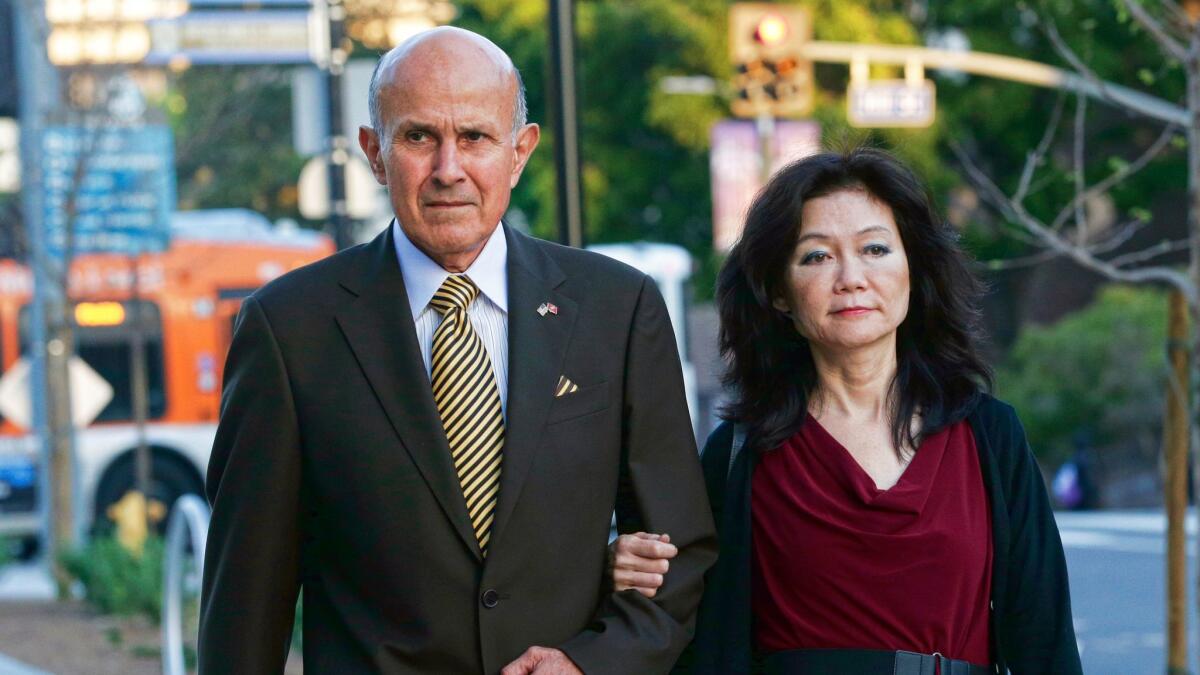Editorial: The Lee Baca saga is over, but plenty of questions remain about the future of the L.A. Sheriff’s Department

The criminal conviction of former Los Angeles County Sheriff Lee Baca is a mark of shame not just for Baca or for the Sheriff’s Department, but for all of Los Angeles County — and for the way we select and oversee one of California’s most powerful officials.
Jurors on Wednesday found Baca guilty of masterminding a scheme to block a federal investigation into the abuse of jail inmates by his deputies. The verdict is the latest chapter in his long, sometimes triumphant and often odd saga (Baca says he will appeal). Last year, Baca agreed to plead guilty and serve up to six months in federal prison, but U.S. District Judge Percy Anderson rejected the plea bargain because the sentence in his view trivialized the seriousness of the offense. He now faces up to 20 years.
A reformer who sought to reduce recidivism by offering inmates education, Baca was popular with voters. They first elected him in 1998 and returned him to office three more times, despite a variety of disturbing reports of problems in his department, including deadly jail race riots and a string of inmate-on-inmate killings — one at the hands of an inmate who was able to leave his cell and wander the jail to track down his victim. Baca struggled with his budget, and in the midst of one shortfall approaching $25 million, his department bought a $2.4 million airplane. He argued for a sales tax increase to keep his deputies ahead of sharply rising crime — even though crime, at the time, was falling. He handed out badges and other official-looking credentials to civilian supporters. Stories circulated about deputies severely abusing jail inmates. The electorate seemed undisturbed.
The Baca saga should raise the question of whether electing the sheriff is a good idea.
As sheriff, Baca was the best-known and politically most powerful figure elected by the voters of Los Angeles County, a jurisdiction of 10 million people. His endorsement and his photo on campaign mailers were highly sought after by candidates for other offices — although, befitting Baca’s sometimes maddening style, he would occasionally endorse more than one candidate in the same race. Challenging him for re-election was virtually futile, given his name recognition and his fund-raising prowess.
His political fortunes were also protected by the nature of his office. High-propensity Los Angeles County voters — generally wealthier and whiter — for years had little knowledge of the communities on which the patrol and incarceration functions of the Sheriff’s Department fell heaviest.
Inmate beatings were steadily catalogued by the ACLU of Southern California. By 2010, a series of investigative stories by The Times and the online news outlet WitnessLA had brought the abysmal conditions of the county jails and the abuse of inmates at the hands of deputies to broader public attention. Meanwhile, activist Patrisse Cullors organized families of people incarcerated in county jails, created the group Dignity and Power Now, and for the first time in the modern era compelled a deeper focus on communities other than those who repeatedly returned Baca to office. Nevertheless, Baca sailed to re-election in 2010 without an opponent.
There came a point at which Baca’s ineptitude or malice could no longer be ignored. A Citizens Commission on Jail Violence offered a searing assessment in 2012, and broadly hinted that Baca should not be in office. He announced his retirement in 2014, with nearly a year remaining in his term.
Undersheriff Paul Tanaka — a career sheriff’s officer and the elected mayor of Gardena — was convicted last year and sentenced to five years in prison for his role in obstructing the federal probe. In defending himself, Baca’s legal team sought to portray the sheriff as a somewhat clueless leader who was unaware of misconduct taking place under his nose. But prosecutors showed jurors a man who tolerated violence in his jails, orchestrated a cover-up and lied about it.
The post-Baca years have been marked by long-overdue efforts to make sure that a sheriff can never again shield himself and his department from accountability. The Board of Supervisors hired an inspector general and created a civilian oversight commission — moves welcome in theory, but not yet proved sufficient. The interim sheriff removed some Tanaka cronies, a house-cleaning continued by Sheriff Jim McDonnell, who also is working to raise standards for integrity and performance.
These steps may be enough to keep future sheriffs from similarly abusing their power, but there is no guarantee. Los Angeles County sheriff remains an elected office in a jurisdiction in which voters still have too little insight into how the department performs its task. The Baca saga should raise the question of whether electing the sheriff is a good idea. His conviction brings his part of the saga to its conclusion. The task of putting the department back together will remain for a good long time to come.
Follow the Opinion section on Twitter @latimesopinion and Facebook
UPDATES:
4:50 p.m.: This editorial was updated with additional details and analysis.
More to Read
A cure for the common opinion
Get thought-provoking perspectives with our weekly newsletter.
You may occasionally receive promotional content from the Los Angeles Times.










